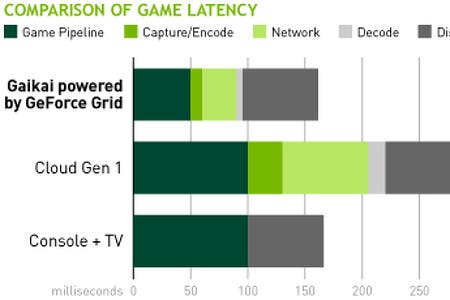Nvidia claims GeForce Grid processor will make game streaming "as common as renting a movie online"
Has achieved a 30ms reduction in latency.
Nvidia has announced its GeForce Grid processor, tech it believes will make game streaming "as common as renting a movie online".
It intends to improve current cloud gaming services by using one big server powered with GPU acceleration based on Nvidia's Kepler technology that can handle multiple game instances. This, Digital Foundry's Rich Leadbetter explains, would amount to a "big advance".
The Nvidia GeForce Grid processor lets you play games from the cloud on any display, including TVs, monitors, notebooks, tablets and smartphones. It is the first GPU designed specifically for cloud game servers.
"First-generation cloud gaming platforms suffer from long latency or lag, low-quality graphics and high costs because of a 1:1 ratio of game streams to data center servers," Nvidia said. "Nvidia GeForce Grid technology resolves these obstacles and will make game streaming as common as renting a movie online."
The specs of the Grid board are as follows:
- CUDA Cores: 3072.
- Memory Size: 8GB.
- Memory Performance: 320 GB/sec.
- Shader Performance: 4.7 TFLOPS.
- TDP: 250W.
"Gaming PC GPUs get faster every year, while consoles only get updated every 5-10 years," Nvidia continued. "So features and performance available to PC gamers outstrip even the best consoles. This includes support for features such as physics, tessellation, advanced antialiasing, and Nvidia 3D Vision.
"Nvidia GeForce GRID offers the promise of easy access to the power of an Nvidia GeForce Grid Supercomputer from the comfort of the living room. Gamers will be able to experience PC titles on their TV with full features and effects turned on that will deliver incredibly rich graphics not possible before on a console. And because it's streamed from the cloud, this incredible gaming experience isn't confined to the living room TV - gamers can stream it to any device including tablets, PCs, and smart phones."
Nvidia said Grid combats the lag issues its rivals are often accused of, and has achieved a 30ms reduction in latency, an end result that "feels like playing on a local console".

"These improvements are the result of Nvidia's fast and concurrent game capture APIs, on-chip H.264 hardware encoding, and working with cloud game infrastructure providers to place servers next to major cities," Nvidia said. "Plus, new Smart TV makers are working with Nvidia to reduce the input lag time on their Ethernet ports compared to the amount of buffering that usually exists on the HDMI input port to most consumer TVs."

